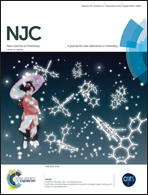Fluorescence modulation of a pyrazolone dye in the solid state based on energy transfer†
Abstract
A new pyrazolone dye was synthesized and its fluorescence modulation was achieved based on energy transfer. The prepared pyrazolone dye was combined with a photochromic pyrazolone to obtain a fluorescence photoswitching material (FPM), which exhibits stable and reversible fluorescence photoswitching properties in the solid state. Upon characterization of the samples through 1H NMR, XRD, FT-IR, UV and fluorescence spectra, it was found that the photochromic pyrazolone and the pyrazolone dye integrally retained their inherent properties in the FPM. An investigation of the FPM revealed that the photoswitching response depended on the fluorescence dye species, the content of the fluorescence dye and the synthetic route of the FPM. The photoswitching mechanism of the FPM was studied in detail using FT-IR, UV and fluorescence spectroscopy. The results show that the photochromism of the photochromic pyrazolone plays an important role in the efficient energy transfer from the pyrazolone dye to the keto-form of the photochromic pyrazolone. The emission wavelength of the pyrazolone dye hardly induces a photochemical reaction of the photochromic pyrazolone in the FPM, which has the potential to be used as a non-destructive fluorescence readout of optical information. This study presents a simple and efficient alternative to covalent systems to obtain FPMs, and it may be applied in photoelectronic devices.


 Please wait while we load your content...
Please wait while we load your content...